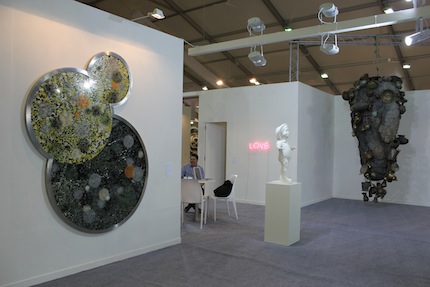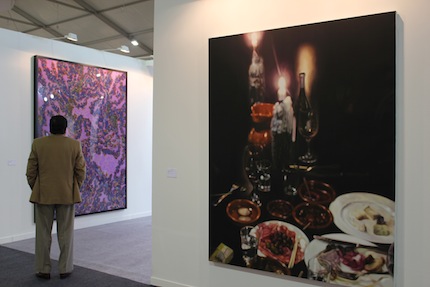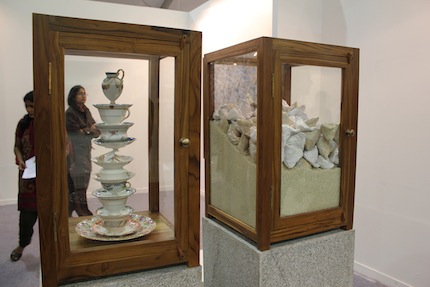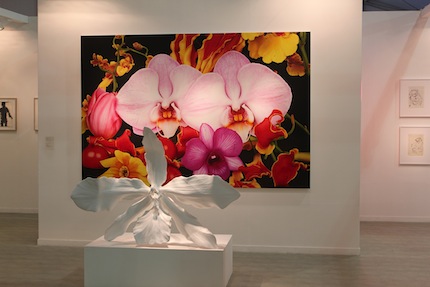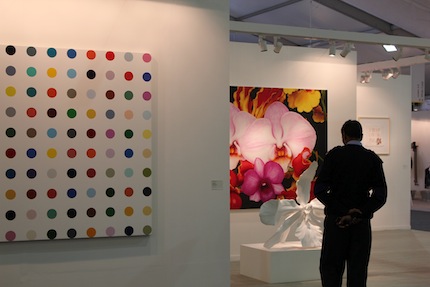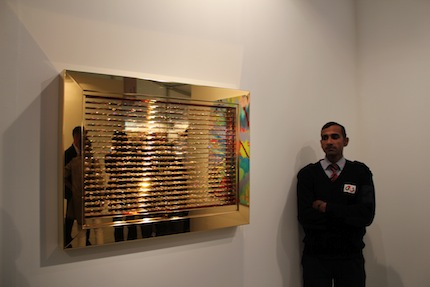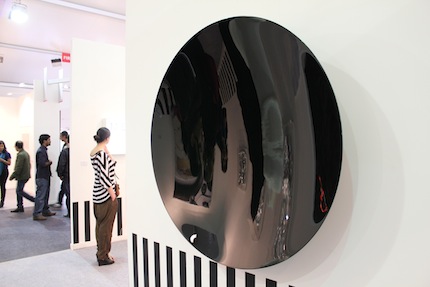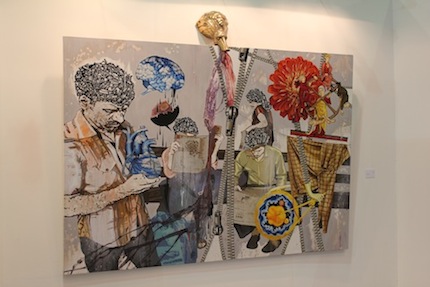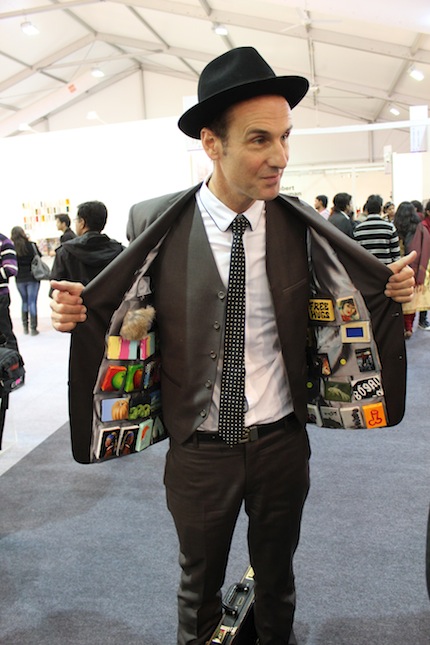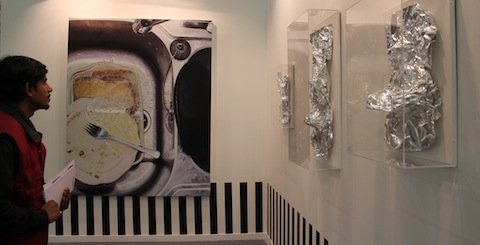
Exclusivity Among the Dust
13/02/2012
Photo:
From January 25th to the 29th, India's contemporary art fair – India Art Fair, was held in New Delhi for the fourth time, attracting attention from the world's most notable galleries, artists and collectors. Representing 1000 contemporary and modern artists, 91 galleries from 20 countries took part in the fair this year.
This exclusive event is always highly anticipated in the city, at which time it becomes a mecca for art. Among all of the countless award shows, exhibition openings, book presentations and performance premiers, this is the week to find new contacts and promote cooperative possibilities.
One should start with the fact that India Art Fair saw big changes this year in terms of location – the fair was not held at the state-sponsored Pragati Maidan exhibition complex as in previous years, but rather at the NSIC Exhibition Grounds, where spacious tents were set up especially for the fair's artistic elites. Although the new site is an approximately 45 minute-drive from the center of New Delhi, the time spent in the overly-aromatic taxi provided an extra opportunity for viewing the urban Indian landscape and the daily lives of its inhabitants. Unfortunately, there wasn't anything terribly exciting to see, since everything seemed uniformly covered in dust. But then again, this wasn't my first time in Delhi, and I probably already know what to expect. When the car stops at the gray and uninteresting entrance gate to the grounds, the security guards for the refined art event begin to threateningly yell at my driver – it seems we've pulled over in a no-stopping zone. I frantically give the driver his money and jump out.
I run past the stern sentries, after which follows a ten minute-walk. When I've finally crossed the seemingly unending track of dirt, sand, asphalt and persistent dust, I come upon the security check, which is as thorough as those in modern-day airports. I must go through a metal detector, while my personal belongings slide along a conveyor belt and through a scanner. After passing successfully, a brightly colored sticker is affixed to my bag and I can now effectively turn my attention towards art.
As the door of the tent opens, I feel as if I have entered another world – I'm surrounded by a cloud of camera lenses, and even though I'm surprised and I step back at first, I rather feel like a guest of honor.
Subodh Gupta and Bharti Kher. Gallery – Houser & Wirth
The first exhibition that comes into view is a big one, of the gallery Houser & Wirth (London, New York, Zurich); from a distance I can already see the grandiose sculptures by Subodh Gupta and Bharti Kher. This is the prestigious gallery's first time at India Art Fair. I must admit that I'm fascinated by Bharti's work, and this time as well, I linger by the webbing of broken glass that is covered with thousands of different bindis (the Hindu symbol for the third eye, which women wear on their forehead). One of Bharti Kher's mirror sculptures is already sold, but the other one is still available for 125 thousand euros.
Bharti Kher “The mistress and the master of grand ceremonies”. Gallery – Galleryske
The names of these two artists are regularly repeated at the stands of other galleries as well – the gallery Continua (San Gimignano, Beijing, Le Moulin) has on offer paintings by Subodh Gupta depicting dinner rituals, while the Bangalore gallery Galleryske displays Kher's mirror-paintings and a clever sculptural-group titled “The Mistress and the Master of Grand Ceremonies”. The public isn't allowed too close to this installation propped up on teacups – the floor of the tent is made of thin plywood, which uses the vibrations from footfalls as an opportunity to topple over the most delicate of works. Most of the gallery owners can't stop worrying about the slightest movement, whereas London's White Cube representatives have taken advantage of the unstable flooring to put into motion Anthony Gromley's sculpture, thereby demonstrating its human qualities.
Marc Quinn. Gallery – White Cube
It is also White Cube's first year at India Art Fair, and they have chosen Mark Quinn as their featured artist. Quinn lucidly describes the meaning behind his orchid works: “These blooms were all bought in London – on the same day. In nature, these orchids would not be blooming at the same time, and they shouldn't even be in a northern climate. This makes me think about human desires, which today serve as an intermediary for the natural – for nature and evolution. Desire has always dictated the path of evolution, but today, this desire is commanded by our consumerist society. I find that interesting.”
In the foreground - Damien Hirst “Spot Paintings”. Gallery – White Cube
Damien Hirst “White Lies”. Gallery – White Cube
White Cube's exposition also includes paintings by Sarah Morris, drawings by Trecey Emin, and Damien Hirst's works from the series “Spot Paintings” and “Spin Paintings”, as well as a conceptual gold shelf with diamonds set out in nice little rows. A guard stands nearby, never leaving the side of the glittering object, but he doesn't seem to be very interested in watching over the viewing public. It turns out that the title of this valuable piece of art is “White Lies” – it's not made of gold, but gilded stainless steel; and the “diamonds” are actually just cubic zirconia (imposter diamonds). The price of the object, however, is unchangingly impressive – 540 thousand sterling pounds.
Still, even if I had that much spare change, I'd rather spend half a million on Anish Kapoor's “Untitled”, which could be seen at the Continua gallery's stand.
Anish Kapoor. Gallery – Continua
Standing in front of this dark green, almost black, “plate”, you feel like you're just a microscopic blip in the universe. The piece invites curiosity and gives one the urge to come closer to its mirror-like surface – to see if this really isn't a doorway to nowhere. Unfortunately, the yellow line on the floor indicates that you'll have to leave that for another time. Works by the Bangalore-born Anish Kapoor have been exhibited at other India Art Fairs, which is why it is a bit surprising that there aren't any at the Lisson gallery's stand this year. Lisson's (London) participation at India Art Fair has always been linked with Kapoor's sculptures, but this year, they have opted to exhibit a solo show by Marina Abramović. Titled “The Kitchen Series”, the central works were inspired by Marina's childhood memories of her grandmother's kitchen in Serbia; at the same time, they also contain elements of India and its culture. The gallery rep ads: “Now we pretend that this choice wasn't a risk (laughs). Our stand has been very well received. It's nice that a curator helped us create the exhibition – that we can excite the public with the works of just one artist and that all of the objects in the stand are unified by one story.” Abramović's works are being offered for prices ranging from 25 thousand euros for the smallest photographs, to 190 thousand euros for a video work.
As one of the most daring exhibitions, I must mention the Mumbai gallery's Project 88 solo presentation of works by the Raqs Media Collective; the witty artists have created works that not only contain hidden riddles, but also encourage a dialog with the viewer. Four pieces of furniture linked with words (time – table, flying – carpet, wrong – chair, stage – mirror) have a subjective meaning for every member of the viewing public. Conceptual exhibits are always a rarity at art fairs! The price of the work – 50 thousand euros.
Jitish Kallat
Most of the Indian galleries featured a repetition of the same local contemporary artists – Subodh Gupta, Bharti Kher, Jitish Kallat, Mithu Sen, Rashid Rana and Ravinder Reddy. Of course, the presence of these artists indicates the galleries' high level of professionalism, since their names are now among the most sought-after in the global art scene. Later, I found out that in India, it is not characteristic of Indian artists to work with just one gallery, as it is in Europe and the USA. In addition, this sort of indecisiveness by the artists creates the opportunity for Indian art collectors to talk-down prices.
Works by Indian modernists (M.F. Husain, S.H. Raza, F.N. Souza) are also not uncommon in the aristocratic art galleries at the fair. Close by is Die Galerie's (Frankfurt) stand with impressive masterpieces by Marc Chagall (490 thousand euros) and Salvador Dali (220 thousand euros). And then there's Frida Fine Arts' (Moscow, Berlin) stand, featuring a catalog of available Jackson Pollock works of art, ranging in price from 4 million to 9 million euros.
An interesting addition to this year's diverse gallery offerings was the debut of the solo project section, where the expositions were based on the work of just one artist. Notables in this division were: Bharti Kher's sculpture “Lady with an Ermine”; the Australian Sam Jinks' realistic sculptures – “Small Things” and “Woman and Child”; Rashid Rana's works titled “Language”; and Simone Slee's conceptual exhibition “How Long?”. This was definitely one of the most successful new additions to the fair!
An interesting aside is that most of the European galleries represented were working with contemporary Indian artists already before they began participating at India Art Fair – Houser & Wirth (Subodh Gupta, Bharti Kher), White Cube (Raqib Shaw), Galeria Continua (Shilpa Gupta, Subodh Gupta, Anish Kapoor), Lisson (Anish Kapoor, Rashid Rana), Krinzinger (Sakshi Gupta, Mithu Sen, Sudarshan Shetty, Avinash Veeraraghavan). This mutual cooperation was visibly reflected in the exhibited stands, where works by contemporary Indian artists were displayed alongside those of the galleries' non-Indian artists.
Latvia's “Galerija 21”, for which this was the third year representing the Northern regions at the fair, followed this same principle. This year, their stand created an interplay between the works of Anda Lāce, Harijs Brants and Anita Arbidāne, and those of the Indian artist Shantam ani. The elegant restraint of “Galerija 21's” exposition, in comparison with the saturated fair environment, made the gallery's presence especially attractive and noticeable; the overwhelmingly positive response from everybody – visitors, the media and the fair's organizers – has already resulted in an invitation to next year's India Art Fair.
The participation of international galleries proves that the fair is ever-increasing its role in the global art environment. Of course, taking part in an event like this can be seen as an advantage for every gallery in itself, but it is also a wonderful opportunity to bring attention to your country. Last year, 128,000 people attended India Art Fair, and this year's numbers are expected to be even greater. In such a widely-attended event such as India Art Fair, a gallery representing its artists is also fulfilling the functions of an ambassador.
It is not for naught that the notable exposition by the gallery White Cube is financially supported by the state; it not only gives the fair's visitors the opportunity to become acquainted with Britain's greatest artists, but it is a representation of the country itself. That's something to think about!
Without a doubt, the wealth of impressions gained by visiting India Art Fair is testimony that India's contemporary art market has assuredly declared its competitive capacity among the world's art centers. International galleries decline to comment on which pieces were sold because, due to the increasing Indian bureaucracy, this year the fair had to be officially presented as just a platform for forming new contacts. Even though transactions were agreed upon, the actual buying and selling process will only take place once the gallery has returned to its home country.
But business will be done!
